
- English
- ePUB (mobile friendly)
- Available on iOS & Android
Computer Modeling in the Aerospace Industry
About This Book
Devoted to advances in the field of computer simulation of aerospace equipment, this study is the most up-to-date coverage of the state-of-the-art on coastal and passenger aircraft, drones, and other recent developments in this constantly changing field.
This book is devoted to unique developments in the field of computer modeling in aerospace engineering. The book describes the original conceptual models of amphibious aircraft, ground-effect vehicles, hydrofoil vessels, and others, from theory to the full implementation in industrial applications.
The developed models are presented with the design of passenger compartments and are actually ready for implementation in the aircraft industry. The originality of the concepts are based on biological prototypes, which are ergonomic, multifunctional and aesthetically pleasing. The aerodynamic layout of prospective convertible land and ship-based aircrafts of vertical and short takeoff-landing is presented, as well as the development of the original model of the unmanned aerial vehicle, or drone. The results of full-scale experiments are presented, including the technology of modeling aerospace simulators based on the virtual reality environment with technical vision devices.
Whether for the practicing engineer in the field, the engineering student, or the scientist interested in new aerospace developments, this volume is a must-have.
This groundbreaking new volume:
- Presents unique developments of coastal aircraft concepts based on biological prototypes, from the idea to the finished model
- Gives the process of modeling the original unmanned aerial vehicle
- Investigates aerospace simulators based on virtual reality environment with technical vision devices
- Covers the original ideas of creating carrier-based aviation for sea ships and the results of field experiments simulating an unmanned aerial vehicle
- Provides many useful illustrations of naval aviation
Audience:
The book is intended for aerospace engineers, mechanical engineers, structural engineers, researchers and developers in the field of aerospace industry, for aircraft designers and engineering students. It will be useful for scientists, students, graduate students and engineers in the field of naval aviation and space simulators.
Frequently asked questions
Information
Chapter 1
Computer Simulation in Aircraft
Abstract
1.1 Simulation of Aircraft
- – at the first stage, we determine the sequence of creation of structural parts and the corresponding methods for this;
- – at the second stage we carry out the general assembly and completion of the device as a whole;
- – at the third stage, to create a realistic model, we perform toning and final rendering of the model of the aircraft.


1.2 Simulation of Rocket
Table of contents
- Cover
- Title Page
- Copyright
- Dedication
- Abstract
- Preface
- Chapter 1: Computer Simulation in Aircraft
- Chapter 2: Conceptual Modeling of Amphibian Aircrafts
- Chapter 3: Development of Schemes of Multirotor Convertiplanes with Cryogenic and Hybrid Powerplants
- Chapter 4: Conceptual Design of A Multifunctional Amphibious Plane
- Chapter 5: Mathematical Model of Unmanned Aircraft with Elliptical Wing
- Chapter 6: Technology of Geometric Modeling of Dynamic Objects and Processes of Virtual Environment for Aviation-Space Simulators Construction
- Index
- End User License Agreement